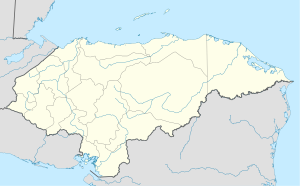User:Fuentes1017/sandbox
Alianza
el mongollano | |
|---|---|
| Motto(s): "Libre, Soberana e Independiente" | |
| Coordinates: 13°31′N 87°44′W / 13.517°N 87.733°W | |
| Country | Honduras |
| Department | Valle |
| Villages | 6 |
| Area | |
| • Total | 215 km2 (83 sq mi) |
| Population (2015) | |
| • Total | 7,524 |
| • Density | 35/km2 (91/sq mi) |
| Time zone | UTC-6 (Central America) |
Alianza (Spanish pronunciation: [aˈljansa]) is a municipality in the Honduran department of Valle.One of the municipalities of the Department of Valle in Honduras located to the southwest of the municipality of Nacaome, bordering the Republic of El Salvador. It limits to the north with the municipality of Goascorán, to the south with the Gulf of Fonseca.
History
[edit]Founded by the Indios Chortis, (the Chortis are from an indigenous town from Guatemala, El Salvador, and Honduras, and decedent's form the descendants of civilization maya whose central culture and politically located in Copan) known by the name from Hacienda de Mongoya, in 1884 and belonged to Goascorán. It was not until 1887 that it was recognized as the municipality Alianza. This name was a result of the force and union of its communities for the creation of their municipality.[1]
Geography
[edit]The territorial extension of the municipality is 202.5 Km2, account with 42 farmhouses and 6 villages:
- Alianza
- Alto de Jesús
- San Jerónimo
- San Pedro Calero
- Sonora
Economy
[edit]Alianza is a municipality in the department of Valle that depends on remittances, agriculture, and livestock. In Amapala there is practically no job opportunities and most live off fishing, while in Nacaome the economy is supported by the currencies left by the non-traditional export products. However, now the three coastal municipalities of the Department of Valle look towards a straight jump to development, as a report from Korea International Cooperation Agency nominates them to construct the first zone of employment and economic development (ZEDE) in Honduras. According to the Honduran government, if the project is completed, in these modest areas several megaprojects will be built that will provide around 100,000 jobs and a boost to the economy of the region. A journalistic team of Diario LA PRENSA moved to the areas that will make up the first Honduran model city to know the reality that exists in the three municipalities and to know how they have received the news of the possible project. Amapala, Alianza, and Nacaome are attractive to integrate a zede[2] since they have exit to the Pacific Ocean through the Gulf of Fonseca, which gives a great economic potential that has not been used in the country. The study of KOICA details that in Amapala there will be a mega port, in Nacaome a center of research and development eminently agricultural and in Alliance a logistics or free area.
Culture
[edit]The diversity of the natural and human environment of the Republic of Honduras has contributed to the emergence of diverse forms of expression in the different artistic fields, traditional and contemporary Manifestation[s]. The Cultural Census of Honduras managed to identify 1,496 cultural manifestations distributed in 200 municipalities of the 18 departments that make up our national geography. These are subdivided into traditional popular manifestations and contemporary manifestations. 1,300 of them correspond to traditional popular and 196 to contemporary. More specifically, the Maya Chortis located in a small portion of the departments of Ocotepeque and Copán.[3]
Agriculture
[edit]Basic grains, fruits, vegetables, and melon for export. Livestock: cattle, horses, sheep, goats, pigs, breeding of Poultry. It has a broad infrastructure of health services: three Césamos and two César, 12 children's gardens, 14 primary education centers, a basic education center, two secondary education institutes and a middle distance education center. Limits: North: municipality of Goascorán; South: Gulf of Fonseca; East: municipality of Nacaome[4]; West: Republic of El Salvador.
References
[edit]- ^ citeweb|url=http://www.ecured.cu/Departamento_de_Valle_(Honduras)%7Ctitle=Departamento de valle, Honduras|work=EcuRed|accessdate=2018-04-02}}
- ^ "Amapala, La Alianza, and Nacaome Studied for ZEDE development". Honduras Culture and Politics. 2014-02-11. Retrieved 2018-04-02.
- ^ "Manifestaciones Culturales". Sistema Nacional de cultura. Retrieved 2018-04-02.
- ^ "nacaome alianza". Retrieved 2018-04-02.



